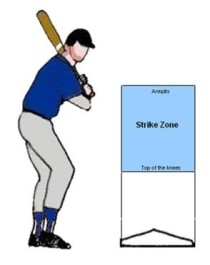Home Plate Umpiring Essentials
What should my strike zone be?
- Little League Rule Book states: "The strike zone is that space over home plate which is between the batter's armpits and the top of the knees when the batter assumes a natural stance. The umpire shall determine the strike zone according to the batter's usual stance when that batter swings at a pitch."
- During the game, the consistency of your strike zone is key, especially during a batter's at-bat sequence. I've heard many a coach and parent mutter complaints about a strike zone but then finish with "... but it was consistent". Translated = great job Blue!
Key factors in determining your strike zone for each game
- You should follow the Little League definition of the strike zone and make discretionary adjustments based on various factors to help keep the game moving and players engaged.
|
Factor |
Description |
| Batter's natural and usual stance |
Some batters crouch when they swing. Others stand more upright.
You should observe the first swings of a batter to determine their stance and adjust your strike zone accordingly. For example, you should tighten your strike zone on a batter who crouches during his/her swing. |
|
Age of the players |
The younger they are, the bigger (height and width) your strike zone should be. A generous strike zone for younger players (< 11 years old) will have them swinging often, keep the defense alert and speed up the game for everyone. |
| Time of season |
At any age, your strike zone should be bigger at the beginning of the season and become smaller as pitchers become more proficient. |
| Just because ... | Whether it's a game with inexperienced pitchers, nasty weather, kids that won't swing, a bad stomach ache, or all of the above - you will find times when your strike zone is just not big enough! |
How and when to make strike zone adjustments during a game
- Personally, I don't like to lower or raise my strike zone too much in part because it's easier for others to spot vertical variations over the course of the game. Expanding the strike zone vertically (a bit above the armpits and below the top of knees) works with younger players. But make these adjustments earlier rather than later in a game.
- Conversely, you have much greater flexibility to expand or shrink your strike zone and have more room for error on the outside or inside of the plate where practically nobody can notice the difference. Expanding the strike zone horizontally (a bit further inside or outside of the plate) works great when you need to adjust the strike zone during a game.



